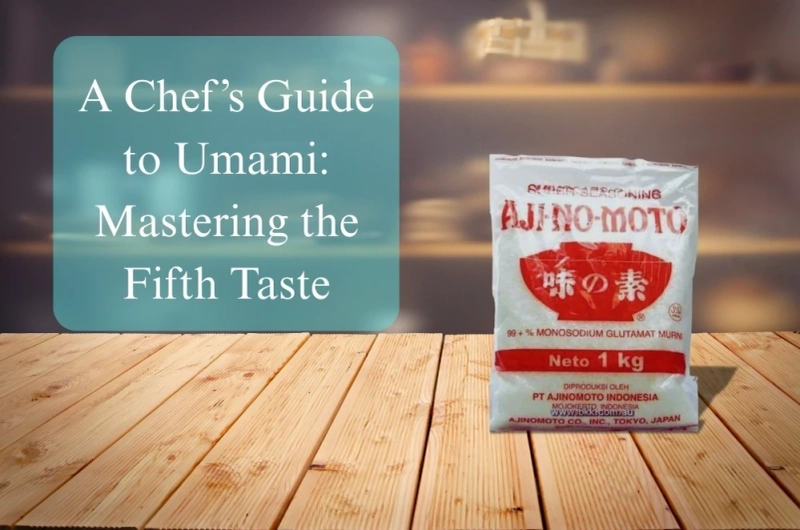Umami doesn’t shout; it rounds off the edges. A broth that tastes fine at lunch can feel richer at dinner after a slow simmer and the lightest pinch of glutamate. In a home kitchen, the real work is simple: keep reliable staples on hand and season with a steady hand. For most cooks, that means knowing where to buy msg in Australia, then noticing when a quarter-teaspoon makes a sauce “click” — and when tomatoes, mushrooms, or long-cooked onions have already done the heavy lifting.
What umami actually is (and how to recognise it)
If sweet, sour, salty, and bitter are the obvious notes, umami is the low, warm hum underneath. It’s linked to glutamates and certain nucleotides that signal “protein here” to our taste receptors. In practice, it shows up as:
- A savoury fullness that makes broths, stews, and sauces feel round and complete
- Longer-lasting flavour—tiny amounts can make a dish taste “deeper” for more bites
- Gentle salt reduction opportunities, because umami boosts perceived savouriness
- Synergy: glutamate plus nucleotides (think mushrooms + dried seafood, or tomatoes + cured meats) multiply each other
In side-by-side tastings, I’ve found a simple stock seasoned with fine sea salt tastes linear, while the same base with a pinch of glutamate becomes broader and more “present,” even at the same total salinity.
Using MSG like a pro: dosage, timing, synergy
Monosodium glutamate is a precise way to add umami without altering texture. It dissolves cleanly, behaves predictably, and is easy to measure—useful when consistency matters from meal to meal.
- Dosage: In most savoury dishes, 0.1–0.4% of the total weight (1–4 g per litre/quart of soup) is plenty. Start low; umami should support, not announce itself.
- Timing: Add early to broths and sauces so it integrates; finish with salt and acid to balance.
- Synergy moves: Pair glutamate with inosinate/guanylate sources—mushrooms, slow-cooked meats, cured products—for a multiplier effect.
- Everyday swaps: If a dish feels flat, try a tiny pinch of MSG before reaching for more salt or fat. Often, the “missing something” is umami, not sodium or richness.
Two quick examples from my own kitchen notes: a tomato ragu that felt edgy smoothed out with 0.3% MSG and a squeeze of lemon at the end; and a roast chicken pan sauce popped into focus when a pinch of glutamate joined the reduced jus and mushrooms.
Safety, labelling, and buying online without surprises
In Australia, MSG (additive 621) is regulated and, when it’s added to a product, it has to be shown on the label. If you prefer ordering pantry staples online—especially from overseas—border rules can kick in, including biosecurity checks, ingredient verification, and inspections on arrival. Government guidance on msg online shopping outlines those checkpoints; in practice, that means buying from sellers who label clearly and being ready for routine screening if an item looks unusual or is misdeclared.
Pantry strategy: crystalline, blended, or “built-in” umami
There’s more than one path to umami. Choose the format that fits how you cook and how you like to season.
- Crystalline MSG (pure): Best for tight control. A digital scale or 0.5 g measuring spoon helps you stay in the 0.1–0.4% range.
- Seasoning blends: Salt/MSG mixes provide convenience; check labels so sodium doesn’t run away from you.
- Ingredient-first: Dried mushrooms, miso, anchovy, tomatoes, long-cooked onions—use these to “build” umami and finish with a pinch of glutamate only if the dish still feels thin.
- Storage & shelf life: Keep MSG dry and sealed; it’s stable but clumps in humidity. Blends behave like salt—store away from steam and stovetop splatter.
If you’re mapping out options or comparing formats for your own workflow, knowing where to buy umami seasoning often sits at the centre of a planning list—crystals for precision, blends for quick service, and “built-in” umami ingredients for depth.
Menu moves: simple ways to layer umami at home
You don’t need restaurant tricks to make umami work. A handful of small, repeatable techniques go a long way.
- Soup & broth: Season lightly with salt early, then taste near the end; if the middle still feels hollow, add a pinch of MSG and simmer 2–3 minutes to integrate.
- Tomato-based sauces: Tomatoes bring glutamate; boost with mushrooms or a little cured meat for nucleotide synergy, then use a pinch of MSG if needed.
- Plant-forward mains: Roasted mushrooms, charred brassicas, and caramelised onions deliver umami; MSG tops up without adding fat.
- Marinades & rubs: A tiny percentage of MSG in a dry rub can make grilled vegetables and proteins taste more “complete” at lower salt levels.
In blind tastings with friends, the “better” version is rarely identified as “more umami”—it’s described as cleaner, richer, or simply more like itself.
Ajinomoto and the Australian kitchen
Plenty of cooks use Ajinomoto-branded MSG because it’s consistent and neutral; it doesn’t add flavour of its own, just the signal that proteins are present. Umami seasoning in Australia reflects straightforward, everyday use—pinches in soups, sauces, marinades, and snacks to bring out inherent character rather than mask it. Used this way, the rest of the pantry does the talking: good stock, ripe tomatoes, honest mushrooms, and careful seasoning at the end.
Troubleshooting: when umami tips too far
Overuse of glutamate doesn’t usually taste “umami,” it tastes muddy—or oddly sweet-savoury—with a lingering heaviness. If you’ve pushed it:
- Add acid (lemon, vinegar, wine) to reset balance; umami likes company.
- Increase aromatic contrast—fresh herbs, black pepper, or a touch of chilli.
- Dilute with unsalted stock or water, then re-season more cautiously.
- For blends, measure by weight next time; volume spoons vary wildly.
I keep a tiny 0.5 g scoop near the salt; it makes restraint a habit. Most dishes brighten with less than you think.
Practical shopping tips without the marketing noise
Real-world pointers from habitual users beat slogans every time:
- Look for clear labelling with the additive number (621) and a single, simple ingredient list for pure MSG.
- Choose pack sizes you’ll finish within a reasonable time; freshness isn’t as critical as dryness, but small clumps can be annoying.
- Bundle orders with other pantry basics to spread shipping costs; keep everything dry on arrival.
- Keep a note of dosage wins in your phone. If 0.2% unlocked your bean chilli once, it’ll likely do so again.
Once you’ve dialled in a few house recipes, most of your “What’s missing?” moments lean on technique—heat control, reduction, acid—while MSG becomes the small, consistent helper.
Final thoughts
Mastering umami is less a revelation and more a set of steady habits. Build depth with ingredients first, then season with intention: a pinch of glutamate in the right place, acid for lift, salt for definition. Shop with an eye for clarity—labels you trust, sources you can return to—and treat online purchases like any other ingredient, with attention to storage and honest expectations. Over time, you’ll find the fifth taste isn’t a magic trick; it’s a reliable way to make your food taste more like itself—balanced, satisfying, and memorable.


